Paul Henderson
3D-ADAM: A Dataset for 3D Anomaly Detection in Advanced Manufacturing
Jul 10, 2025Abstract:Surface defects are one of the largest contributors to low yield in the manufacturing sector. Accurate and reliable detection of defects during the manufacturing process is therefore of great value across the sector. State-of-the-art approaches to automated defect detection yield impressive performance on current datasets, yet still fall short in real-world manufacturing settings and developing improved methods relies on large datasets representative of real-world scenarios. Unfortunately, high-quality, high-precision RGB+3D industrial anomaly detection datasets are scarce, and typically do not reflect real-world industrial deployment scenarios. To address this, we introduce 3D-ADAM, the first large-scale industry-relevant dataset for high-precision 3D Anomaly Detection. 3D-ADAM comprises 14,120 high-resolution scans across 217 unique parts, captured using 4 industrial depth imaging sensors. It includes 27,346 annotated defect instances from 12 categories, covering the breadth of industrial surface defects. 3D-ADAM uniquely captures an additional 8,110 annotations of machine element features, spanning the range of relevant mechanical design form factors. Unlike existing datasets, 3D-ADAM is captured in a real industrial environment with variations in part position and orientation, camera positioning, ambient lighting conditions, as well as partial occlusions. Our evaluation of SOTA models across various RGB+3D anomaly detection tasks demonstrates the significant challenge this dataset presents to current approaches. We further validated the industrial relevance and quality of the dataset through an expert labelling survey conducted by industry partners. By providing this challenging benchmark, 3D-ADAM aims to accelerate the development of robust 3D Anomaly Detection models capable of meeting the demands of modern manufacturing environments.
Multi-Person Interaction Generation from Two-Person Motion Priors
May 23, 2025Abstract:Generating realistic human motion with high-level controls is a crucial task for social understanding, robotics, and animation. With high-quality MOCAP data becoming more available recently, a wide range of data-driven approaches have been presented. However, modelling multi-person interactions still remains a less explored area. In this paper, we present Graph-driven Interaction Sampling, a method that can generate realistic and diverse multi-person interactions by leveraging existing two-person motion diffusion models as motion priors. Instead of training a new model specific to multi-person interaction synthesis, our key insight is to spatially and temporally separate complex multi-person interactions into a graph structure of two-person interactions, which we name the Pairwise Interaction Graph. We thus decompose the generation task into simultaneous single-person motion generation conditioned on one other's motion. In addition, to reduce artifacts such as interpenetrations of body parts in generated multi-person interactions, we introduce two graph-dependent guidance terms into the diffusion sampling scheme. Unlike previous work, our method can produce various high-quality multi-person interactions without having repetitive individual motions. Extensive experiments demonstrate that our approach consistently outperforms existing methods in reducing artifacts when generating a wide range of two-person and multi-person interactions.
ICE-Pruning: An Iterative Cost-Efficient Pruning Pipeline for Deep Neural Networks
May 12, 2025Abstract:Pruning is a widely used method for compressing Deep Neural Networks (DNNs), where less relevant parameters are removed from a DNN model to reduce its size. However, removing parameters reduces model accuracy, so pruning is typically combined with fine-tuning, and sometimes other operations such as rewinding weights, to recover accuracy. A common approach is to repeatedly prune and then fine-tune, with increasing amounts of model parameters being removed in each step. While straightforward to implement, pruning pipelines that follow this approach are computationally expensive due to the need for repeated fine-tuning. In this paper we propose ICE-Pruning, an iterative pruning pipeline for DNNs that significantly decreases the time required for pruning by reducing the overall cost of fine-tuning, while maintaining a similar accuracy to existing pruning pipelines. ICE-Pruning is based on three main components: i) an automatic mechanism to determine after which pruning steps fine-tuning should be performed; ii) a freezing strategy for faster fine-tuning in each pruning step; and iii) a custom pruning-aware learning rate scheduler to further improve the accuracy of each pruning step and reduce the overall time consumption. We also propose an efficient auto-tuning stage for the hyperparameters (e.g., freezing percentage) introduced by the three components. We evaluate ICE-Pruning on several DNN models and datasets, showing that it can accelerate pruning by up to 9.61x. Code is available at https://github.com/gicLAB/ICE-Pruning
Generative Fields: Uncovering Hierarchical Feature Control for StyleGAN via Inverted Receptive Fields
Apr 24, 2025Abstract:StyleGAN has demonstrated the ability of GANs to synthesize highly-realistic faces of imaginary people from random noise. One limitation of GAN-based image generation is the difficulty of controlling the features of the generated image, due to the strong entanglement of the low-dimensional latent space. Previous work that aimed to control StyleGAN with image or text prompts modulated sampling in W latent space, which is more expressive than Z latent space. However, W space still has restricted expressivity since it does not control the feature synthesis directly; also the feature embedding in W space requires a pre-training process to reconstruct the style signal, limiting its application. This paper introduces the concept of "generative fields" to explain the hierarchical feature synthesis in StyleGAN, inspired by the receptive fields of convolution neural networks (CNNs). Additionally, we propose a new image editing pipeline for StyleGAN using generative field theory and the channel-wise style latent space S, utilizing the intrinsic structural feature of CNNs to achieve disentangled control of feature synthesis at synthesis time.
Beyond Reconstruction: A Physics Based Neural Deferred Shader for Photo-realistic Rendering
Apr 16, 2025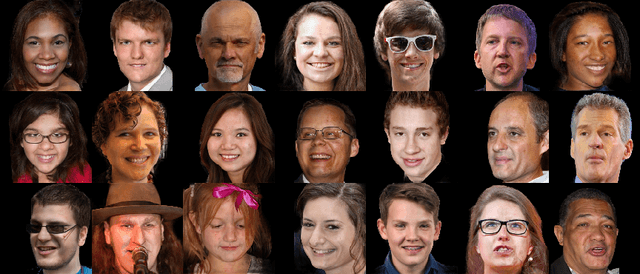
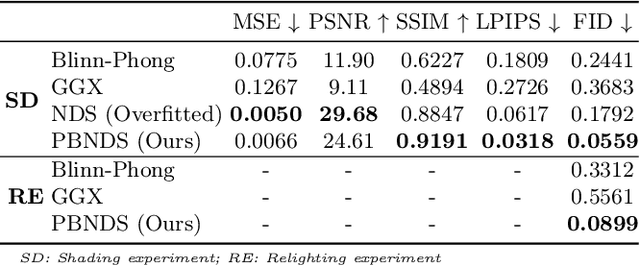


Abstract:Deep learning based rendering has demonstrated major improvements for photo-realistic image synthesis, applicable to various applications including visual effects in movies and photo-realistic scene building in video games. However, a significant limitation is the difficulty of decomposing the illumination and material parameters, which limits such methods to reconstruct an input scene, without any possibility to control these parameters. This paper introduces a novel physics based neural deferred shading pipeline to decompose the data-driven rendering process, learn a generalizable shading function to produce photo-realistic results for shading and relighting tasks, we also provide a shadow estimator to efficiently mimic shadowing effect. Our model achieves improved performance compared to classical models and a state-of-art neural shading model, and enables generalizable photo-realistic shading from arbitrary illumination input.
Differentially Private 2D Human Pose Estimation
Apr 15, 2025Abstract:Human pose estimation (HPE) has become essential in numerous applications including healthcare, activity recognition, and human-computer interaction. However, the privacy implications of processing sensitive visual data present significant deployment barriers in critical domains. While traditional anonymization techniques offer limited protection and often compromise data utility for broader motion analysis, Differential Privacy (DP) provides formal privacy guarantees but typically degrades model performance when applied naively. In this work, we present the first differentially private 2D human pose estimation (2D-HPE) by applying Differentially Private Stochastic Gradient Descent (DP-SGD) to this task. To effectively balance privacy with performance, we adopt Projected DP-SGD (PDP-SGD), which projects the noisy gradients to a low-dimensional subspace. Additionally, we adapt TinyViT, a compact and efficient vision transformer for coordinate classification in HPE, providing a lightweight yet powerful backbone that enhances privacy-preserving deployment feasibility on resource-limited devices. Our approach is particularly valuable for multimedia interpretation tasks, enabling privacy-safe analysis and understanding of human motion across diverse visual media while preserving the semantic meaning required for downstream applications. Comprehensive experiments on the MPII Human Pose Dataset demonstrate significant performance enhancement with PDP-SGD achieving 78.48% PCKh@0.5 at a strict privacy budget ($\epsilon=0.2$), compared to 63.85% for standard DP-SGD. This work lays foundation for privacy-preserving human pose estimation in real-world, sensitive applications.
Divide and Conquer Self-Supervised Learning for High-Content Imaging
Mar 10, 2025Abstract:Self-supervised representation learning methods often fail to learn subtle or complex features, which can be dominated by simpler patterns which are much easier to learn. This limitation is particularly problematic in applications to science and engineering, as complex features can be critical for discovery and analysis. To address this, we introduce Split Component Embedding Registration (SpliCER), a novel architecture which splits the image into sections and distils information from each section to guide the model to learn more subtle and complex features without compromising on simpler features. SpliCER is compatible with any self-supervised loss function and can be integrated into existing methods without modification. The primary contributions of this work are as follows: i) we demonstrate that existing self-supervised methods can learn shortcut solutions when simple and complex features are both present; ii) we introduce a novel self-supervised training method, SpliCER, to overcome the limitations of existing methods, and achieve significant downstream performance improvements; iii) we demonstrate the effectiveness of SpliCER in cutting-edge medical and geospatial imaging settings. SpliCER offers a powerful new tool for representation learning, enabling models to uncover complex features which could be overlooked by other methods.
Actively Inferring Optimal Measurement Sequences
Feb 25, 2025Abstract:Measurement of a physical quantity such as light intensity is an integral part of many reconstruction and decision scenarios but can be costly in terms of acquisition time, invasion of or damage to the environment and storage. Data minimisation and compliance with data protection laws is also an important consideration. Where there are a range of measurements that can be made, some may be more informative and compliant with the overall measurement objective than others. We develop an active sequential inference algorithm that uses the low dimensional representational latent space from a variational autoencoder (VAE) to choose which measurement to make next. Our aim is to recover high dimensional data by making as few measurements as possible. We adapt the VAE encoder to map partial data measurements on to the latent space of the complete data. The algorithm draws samples from this latent space and uses the VAE decoder to generate data conditional on the partial measurements. Estimated measurements are made on the generated data and fed back through the partial VAE encoder to the latent space where they can be evaluated prior to making a measurement. Starting from no measurements and a normal prior on the latent space, we consider alternative strategies for choosing the next measurement and updating the predictive posterior prior for the next step. The algorithm is illustrated using the Fashion MNIST dataset and a novel convolutional Hadamard pattern measurement basis. We see that useful patterns are chosen within 10 steps, leading to the convergence of the guiding generative images. Compared with using stochastic variational inference to infer the parameters of the posterior distribution for each generated data point individually, the partial VAE framework can efficiently process batches of generated data and obtains superior results with minimal measurements.
Zero-Shot Interactive Text-to-Image Retrieval via Diffusion-Augmented Representations
Jan 26, 2025



Abstract:Interactive Text-to-Image Retrieval (I-TIR) has emerged as a transformative user-interactive tool for applications in domains such as e-commerce and education. Yet, current methodologies predominantly depend on finetuned Multimodal Large Language Models (MLLMs), which face two critical limitations: (1) Finetuning imposes prohibitive computational overhead and long-term maintenance costs. (2) Finetuning narrows the pretrained knowledge distribution of MLLMs, reducing their adaptability to novel scenarios. These issues are exacerbated by the inherently dynamic nature of real-world I-TIR systems, where queries and image databases evolve in complexity and diversity, often deviating from static training distributions. To overcome these constraints, we propose Diffusion Augmented Retrieval (DAR), a paradigm-shifting framework that bypasses MLLM finetuning entirely. DAR synergizes Large Language Model (LLM)-guided query refinement with Diffusion Model (DM)-based visual synthesis to create contextually enriched intermediate representations. This dual-modality approach deciphers nuanced user intent more holistically, enabling precise alignment between textual queries and visually relevant images. Rigorous evaluations across four benchmarks reveal DAR's dual strengths: (1) Matches state-of-the-art finetuned I-TIR models on straightforward queries without task-specific training. (2) Scalable Generalization: Surpasses finetuned baselines by 7.61% in Hits@10 (top-10 accuracy) under multi-turn conversational complexity, demonstrating robustness to intricate, distributionally shifted interactions. By eliminating finetuning dependencies and leveraging generative-augmented representations, DAR establishes a new trajectory for efficient, adaptive, and scalable cross-modal retrieval systems.
On the Benefits of Instance Decomposition in Video Prediction Models
Jan 17, 2025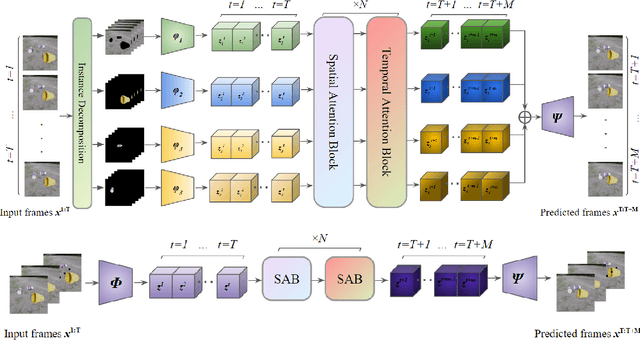
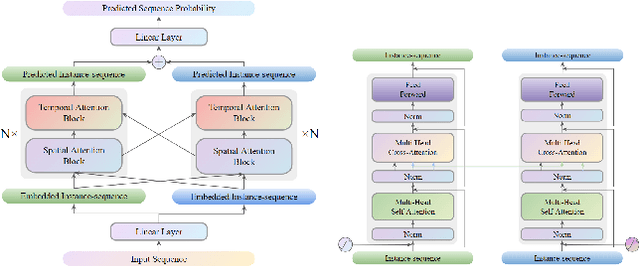

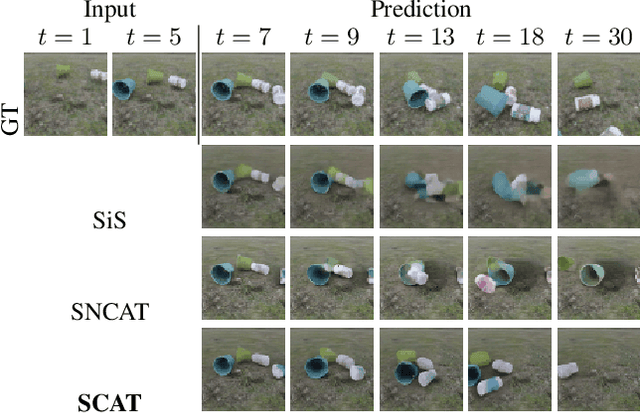
Abstract:Video prediction is a crucial task for intelligent agents such as robots and autonomous vehicles, since it enables them to anticipate and act early on time-critical incidents. State-of-the-art video prediction methods typically model the dynamics of a scene jointly and implicitly, without any explicit decomposition into separate objects. This is challenging and potentially sub-optimal, as every object in a dynamic scene has their own pattern of movement, typically somewhat independent of others. In this paper, we investigate the benefit of explicitly modeling the objects in a dynamic scene separately within the context of latent-transformer video prediction models. We conduct detailed and carefully-controlled experiments on both synthetic and real-world datasets; our results show that decomposing a dynamic scene leads to higher quality predictions compared with models of a similar capacity that lack such decomposition.
 Add to Chrome
Add to Chrome Add to Firefox
Add to Firefox Add to Edge
Add to Edge